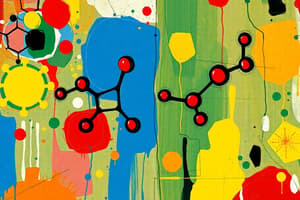Podcast
Questions and Answers
What term describes substances that easily dissolve in water?
What term describes substances that easily dissolve in water?
- Neutral
- Hydrophilic (correct)
- Acidic
- Hydrophobic
What happens to NaCl when it dissolves in water?
What happens to NaCl when it dissolves in water?
- The lattice structure remains intact.
- The ions separate and form spheres of hydration. (correct)
- The ions form larger molecules.
- The ions repel each other.
Which of the following molecules is likely to be hydrophobic?
Which of the following molecules is likely to be hydrophobic?
- Amino acids
- Organic acids
- Lipids (correct)
- Sugars
What type of interactions do polar molecules in cells form with water?
What type of interactions do polar molecules in cells form with water?
Which property of water allows it to dissolve many substances?
Which property of water allows it to dissolve many substances?
How do hydrophobic molecules affect the hydrogen bonding of water?
How do hydrophobic molecules affect the hydrogen bonding of water?
What characteristic do some molecules with no net charge have that allows them to be hydrophilic?
What characteristic do some molecules with no net charge have that allows them to be hydrophilic?
Why do cells require a selectively permeable membrane?
Why do cells require a selectively permeable membrane?
What types of bonds can carbon atoms form with other atoms?
What types of bonds can carbon atoms form with other atoms?
What is the bond energy of a C—H bond?
What is the bond energy of a C—H bond?
Which type of bond requires the most energy to break?
Which type of bond requires the most energy to break?
How is bond energy expressed?
How is bond energy expressed?
Which bond type, among the following, is strongest concerning bond energy?
Which bond type, among the following, is strongest concerning bond energy?
What is the bond energy of a C═C bond compared to a C—O bond?
What is the bond energy of a C═C bond compared to a C—O bond?
What total number of covalent bonds can a single carbon atom form?
What total number of covalent bonds can a single carbon atom form?
How much energy is required to break a C—C bond?
How much energy is required to break a C—C bond?
What is the relationship between wavelength and bond energy in solar radiation?
What is the relationship between wavelength and bond energy in solar radiation?
What is the primary characteristic of biological membranes?
What is the primary characteristic of biological membranes?
Why must ions be transported across a membrane?
Why must ions be transported across a membrane?
Why can't visible light break the bonds of organic molecules?
Why can't visible light break the bonds of organic molecules?
What structural diversity arises from the tetravalent nature of carbon?
What structural diversity arises from the tetravalent nature of carbon?
What role do transport proteins play in cellular membranes?
What role do transport proteins play in cellular membranes?
Which of the following correctly describes hydrocarbons?
Which of the following correctly describes hydrocarbons?
What are macromolecules mainly composed of in the cell?
What are macromolecules mainly composed of in the cell?
What defines biological compounds?
What defines biological compounds?
What types of molecules are considered macromolecules in the cell?
What types of molecules are considered macromolecules in the cell?
How are most cellular structures organized?
How are most cellular structures organized?
What is the role of functional groups in biological compounds?
What is the role of functional groups in biological compounds?
Which of the following statements is true regarding hydrocarbons in biology?
Which of the following statements is true regarding hydrocarbons in biology?
From where do cellular structures obtain their components?
From where do cellular structures obtain their components?
How does the variety of organic molecules relate to the types of atoms involved?
How does the variety of organic molecules relate to the types of atoms involved?
Which statement best describes the synthesis of lipids compared to macromolecules?
Which statement best describes the synthesis of lipids compared to macromolecules?
What primarily determines the function of a protein?
What primarily determines the function of a protein?
Which statement about polysaccharides is correct?
Which statement about polysaccharides is correct?
What is required for a monomer to undergo condensation during polymer synthesis?
What is required for a monomer to undergo condensation during polymer synthesis?
Which molecule provides the energy needed to activate a monomer during synthesis?
Which molecule provides the energy needed to activate a monomer during synthesis?
What distinguishes one end of a macromolecule from the other?
What distinguishes one end of a macromolecule from the other?
Which of the following substances is a storage polysaccharide?
Which of the following substances is a storage polysaccharide?
What is the role of water in the polymerization of monomers?
What is the role of water in the polymerization of monomers?
What is a characteristic of macromolecule synthesis?
What is a characteristic of macromolecule synthesis?
Flashcards are hidden until you start studying
Study Notes
Covalent Bonding of Carbon Atoms
- Carbon forms single, double, or triple bonds by sharing one, two, or three pairs of electrons.
- Each carbon atom can form a total of four covalent bonds.
Stability and Bond Energy
- Stability of carbon-containing molecules is quantified by bond energy, indicating the energy required to break one mole of bonds.
- Bond energy values include:
- C—C: 83 kcal/mol
- C—N: 70 kcal/mol
- C—O: 84 kcal/mol
- C—H: 99 kcal/mol
- Double and triple bonds have higher bond energies:
- C ═ C: 146 kcal/mol
- C ≡ C: 212 kcal/mol
Importance of Covalent Bonds
- Solar radiation's energy is inversely related to bond energy, meaning visible light cannot break carbon-carbon bonds, while ultraviolet light can.
Diversity of Carbon-Containing Molecules
- Carbon's tetravalent nature allows formation of diverse structures including rings and chains, which may branch and contain various types of bonds.
- Hydrocarbons consist solely of carbon and hydrogen and are significant economically but minimally in biology due to their limited solubility in water.
Biological Compounds
- These compounds include carbon, hydrogen, and additional atoms like oxygen, nitrogen, phosphorus, or sulfur, often structured into functional groups that determine their chemical properties.
- Functional groups influence water solubility and reactivity.
Solubility Concepts
- Hydrophilic substances dissolve easily in water and include molecules like sugars and organic acids.
- Hydrophobic substances, including lipids, are not soluble in water and disrupt hydrogen bonding.
Ionic Dissolution
- Ionic compounds like NaCl dissolve in water due to the polar nature of water molecules, which interact with and separate cations and anions.
Selectively Permeable Membranes
- Biological membranes act as barriers, permitting the diffusion of small molecules but restricting larger or charged molecules.
- Ions require transport proteins to cross membranes due to charge and hydration shell constraints.
Role of Transport Proteins
- Transport proteins facilitate movement across membranes, functioning as channels or carriers specific to certain ions or molecules.
Macromolecule Importance and Synthesis
- Macromolecules, essential for cellular structure and function, include proteins, nucleic acids, and polysaccharides.
- These are formed through stepwise polymerization processes where monomers link via condensation reactions, releasing water.
- Activated monomers bind to carrier molecules for polymer synthesis, utilizing energy from ATP.
Characteristics of Macromolecules
- Macromolecules possess directionality, with differing chemistry at each end, and are composed of repeating subunits (monomers).
- Polysaccharides serve structural roles (e.g., cellulose) or storage functions (e.g., starch).
Studying That Suits You
Use AI to generate personalized quizzes and flashcards to suit your learning preferences.



